Step into the lush realm of tropical forests and discover the elusive beauty of the Trogon, a captivating avian species shrouded in mystery and splendor.
With its iridescent plumage and secretive nature, the Trogon reigns as a jewel of the forest canopy, enchanting observers with its ethereal presence.
The Trogon, belonging to the family Trogonidae, encompasses various species in tropical and subtropical regions worldwide.
From the resplendent Quetzal of Central America to the elegant Harpia Trogon of Southeast Asia, each species exhibits unique adaptations and behaviors that reflect its role as a symbol of biodiversity and ecological richness.
Join us to unravel its exquisite plumage, specialized habitat preferences, and enigmatic behaviors. From its musical calls echoing through the forest to its vital role in seed dispersal and ecosystem dynamics, the Trogon beckons us to explore the wonders of the natural world with curiosity.
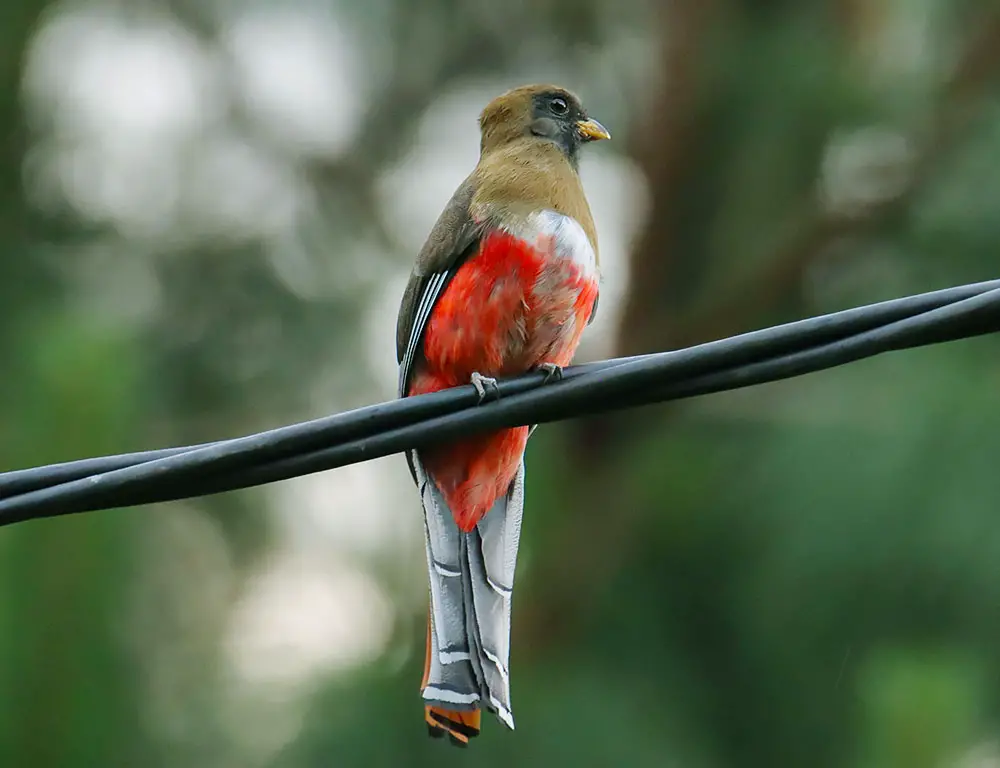
Physical Characteristics of the Trogon
Trogons are diverse birds known for their striking plumage, unique characteristics, and elusive nature. Let’s delve into the physical attributes that define these captivating avian species and set them apart in the tropical forests they inhabit.
Plumage
Trogons are renowned for their vibrant and iridescent plumage, which varies significantly among species. Standard colors include shades of green, blue, red, and orange, often arranged in intricate patterns that provide camouflage in their forest habitats.
Size
Trogons range from small to medium-sized birds, with body lengths typically between 20 to 40 centimeters (8 to 16 inches). While some species are relatively petite, others, such as the Resplendent Quetzal, can reach larger sizes.
Body Shape
Trogons have a compact and robust body shape, short neck, broad chest, and rounded wings. Their bodies are well-adapted for maneuvering through dense vegetation in the forest canopy.
Head and Bill
Trogons have distinctive heads, relatively large eyes, and a short, hooked bill. Their bills are designed for capturing and eating a variety of prey items, including insects, fruits, and small vertebrates.
Tail
One of the most characteristic features of Trogons is their unique tail shape. Many species have long, rounded tails with distinct barring or markings, which they often hold cocked upwards while perched.
Sexual Dimorphism
In some species of Trogons, males and females exhibit sexual dimorphism in plumage coloration. Males may display more vibrant or elaborate colors, while females tend to have duller or more cryptic plumage.
Iridescence
Many Trogons possess iridescent plumage, which appears to change color depending on the angle of light. This iridescence adds to their allure and makes them particularly captivating to observe in their natural habitat.
Voice
Trogons are not particularly vocal birds, but they may produce a variety of calls and vocalizations for communication and territorial defense. These calls range from soft trills and whistles to harsher squawks and chatters.
Flight
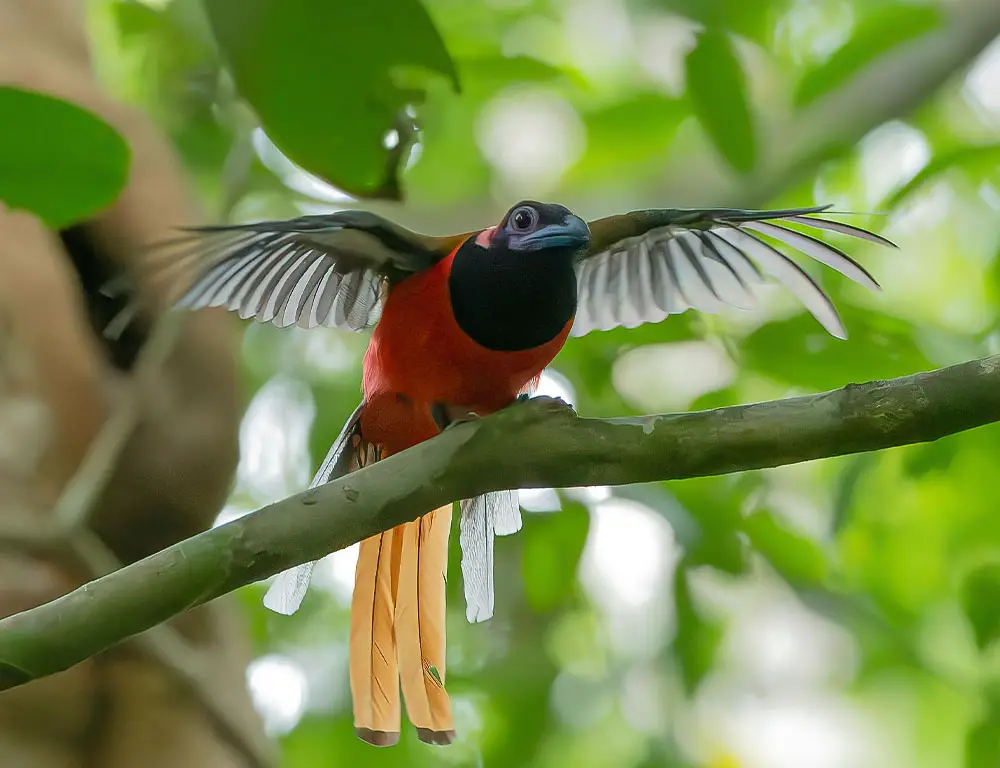
Trogons are agile flyers, easily navigating through the dense forest canopy. Their broad wings and short tails provide excellent maneuverability, allowing them to dart between branches and foliage in pursuit of prey.
Behavior
Trogons are often described as secretive and elusive birds, preferring to inhabit dense forests and woodland habitats where they can find ample cover and protection from predators.
They are typically solitary or found in pairs, except during the breeding season when they may form temporary family groups.
Habitat Preference
Trogons are primarily arboreal birds, meaning they spend most of their time in the forest canopy. They inhabit various forested habitats, including tropical rainforests, montane forests, and cloud forests, where they can find suitable nesting sites and abundant food sources.
Ecological Role
Trogons play a vital role in ecosystem dynamics as predators and seed dispersers. Feeding on insects, fruits, and other small prey items helps regulate populations of insects and contributes to the dispersal of seeds across the forest landscape.
Overall, the physical characteristics of Trogons reflect their adaptation to life in the diverse and complex ecosystems of tropical forests.
From their vibrant plumage to their specialized beaks and agile flight, these birds are remarkable examples of nature’s beauty and ingenuity.
Taxonomy, Distribution, and Breeding Habits of the Trogon
Delve into the intricate world of Trogons as we explore their taxonomy, distribution, and breeding habits.
From their classification within the avian kingdom to their nesting behaviors and geographic range, Trogons offer a fascinating glimpse into the biodiversity of tropical forests.
Taxonomy of the Trogon
| Taxonomy Level | Classification |
| Kingdom | Animalia |
| Phylum | Chordata |
| Class | Aves |
| Order | Trogoniformes |
| Family | Trogonidae |
| Genus | Varies by species |
| Species | Varies by species |
Range Map
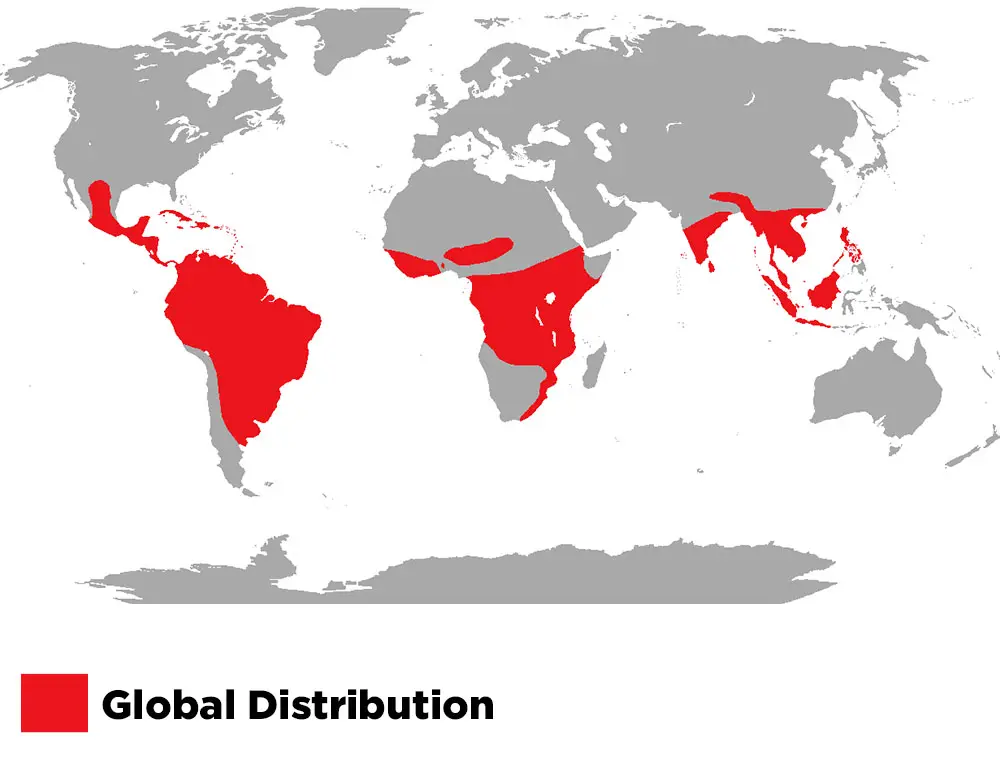
The range map illustrates the distribution of Trogons across their habitat range, which includes tropical and subtropical regions of the world.
Trogons inhabit a wide range of ecosystems, from the lush rainforests of Central and South America to the montane forests of Africa and the cloud forests of Asia.
Food Habits
Trogons have a varied diet that includes insects, fruits, and small vertebrates. They primarily feed on flying insects caught in mid-air, using their specialized bills to snatch prey precisely.
Additionally, they consume various fruits and berries, contributing to seed dispersal within their forest habitats.
Nesting Habits of the Trogon
| Nesting Habit | Description |
| Nest Location | Tree cavities or natural hollows |
| Nest Composition | Leaves, moss, and other vegetation |
| Clutch Size | Typically contains 2-4 eggs |
| Incubation Period | Around 14-21 days |
| Parental Care | Both male and female share incubation and care |
Breeding Habits
Trogons typically breed during the wet season, when food availability is abundant and nesting conditions are favorable. They construct nests in tree cavities or natural hollows, lining them with leaves, moss, and other vegetation.
Both male and female Trogons share incubation and chick-rearing duties until the young fledge from the nest.
Diseases and Treatments
Trogons may be susceptible to various avian diseases, including respiratory infections, parasitic infestations, and injuries.
Treatment options may include veterinary care, including antibiotics, antiparasitic medications, and supportive therapy to aid in recovery. Regular monitoring and management practices can help mitigate disease risks and promote the health of Trogons in their natural habitats.
Is the Trogon Endangered?
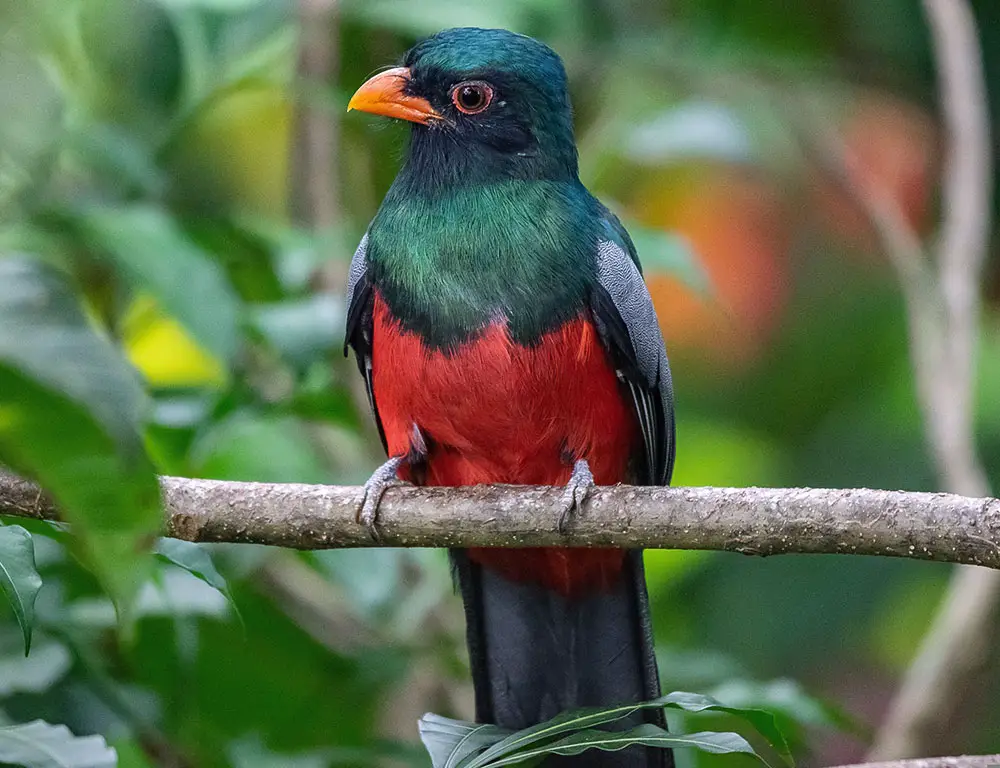
The conservation status of Trogon species varies depending on the specific species and its geographic location.
While some species of Trogons are considered of least concern, others may face threats such as habitat loss, degradation, and fragmentation due to human activities such as deforestation, agricultural expansion, and urbanization.
Certain Trogon species may also be impacted by climate change, which can alter their habitat and food availability. Additionally, illegal trapping for the pet trade and hunting for their feathers or ornamental value may pose additional threats to some populations.
While some Trogon species may be at risk or experiencing population declines, others may remain relatively stable.
Monitoring their populations and habitats closely and implementing conservation measures to protect these charismatic birds and ensure their long-term survival is essential.
Conservation efforts focused on habitat preservation, sustainable land management, and community engagement are crucial for safeguarding Trogon populations and their habitats.
8 Interesting Facts About the Trogon
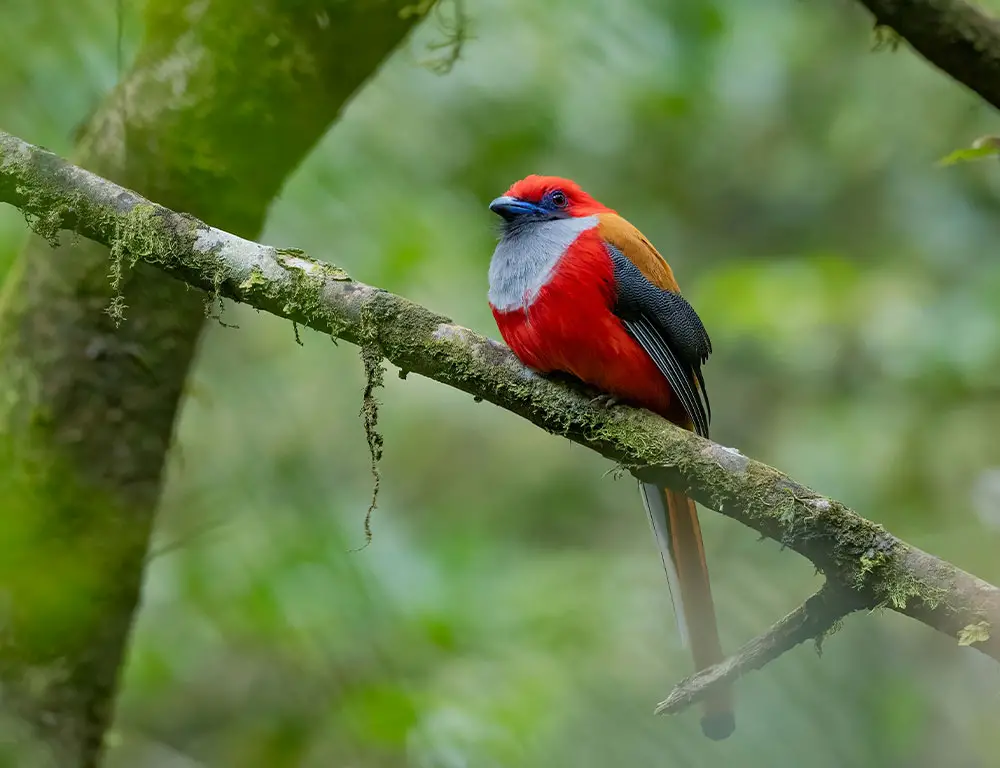
Embark on a journey of discovery as we uncover fascinating insights into the world of Trogons, enigmatic birds of the tropical forests. From their vibrant plumage to their unique behaviors, Trogons are captivating creatures that intrigue and inspire.
1. Cryptic Plumage
Despite their striking appearance, Trogons are masters of camouflage, blending seamlessly into the dense foliage of their forest habitats with their cryptically colored plumage.
2. Elegant Flight
Trogons are known for their graceful flight patterns, characterized by smooth glides and agile maneuvers through the forest canopy. Their broad wings and short tails provide excellent maneuverability in navigating dense vegetation.
3. Muted Vocalizations
Trogons are relatively quiet birds, producing soft and melodious calls often heard during the breeding season. Their vocalizations play a role in communication between mates and territorial defense.
4. Nesting Behavior
Many Trogon species construct nests in tree cavities or natural hollows, lining them with leaves, moss, and other vegetation. They may reuse old nesting sites or excavate new ones each breeding season.
5. Specialized Diet
Trogons have a diverse diet that includes insects, fruits, and small vertebrates. They are particularly adept at catching flying insects in mid-air, using their sharp bills to snatch prey precisely.
6. Role in Seed Dispersal
Trogons are vital in ecosystem dynamics as seed dispersers, consuming fruits and berries, and dispersing seeds across the forest landscape. This helps maintain the diversity of plant species in their habitats.
7. Male Incubation
In some Trogon species, males are primarily responsible for incubating the eggs, while females forage for food. This unique breeding behavior allows both parents to contribute to the survival of their offspring.
8. Cultural Significance
Trogons are significant in many indigenous cultures, often revered as symbols of beauty, wisdom, and spirituality.
Their vibrant plumage and elusive nature have inspired history’s myths, legends, and artistic representations.
FAQs
How do Trogons contribute to their ecosystems?
Trogons play a vital role in ecosystem dynamics as both predators and seed dispersers. By consuming insects and fruits, they help regulate insect populations and disperse seeds, contributing to the maintenance of plant diversity in their habitats.
What is the nesting behavior of Trogons?
Trogons typically construct nests in tree cavities or natural hollows, lining them with leaves, moss, and other vegetation. Both male and female Trogons share incubation and chick-rearing duties until the young fledge from the nest.
Are Trogons vocal birds?
While Trogons are not particularly vocal compared to some other bird species, they may produce soft and melodious calls for communication and territorial defense, especially during the breeding season.
How do Trogons avoid predators?
Trogons rely on their cryptically colored plumage and secretive behavior to avoid predators. They blend into their forest surroundings, making them difficult to detect, and may flee or remain motionless when threatened.
Do Trogons have any cultural significance?
Trogons are significant in many indigenous cultures and are often revered as symbols of beauty, wisdom, and spirituality. They feature prominently in myths, legends, and artistic representations, reflecting their status as iconic forest birds.
Conclusion
The Trogon is a majestic emblem of the rich biodiversity in tropical forests worldwide. Its iridescent plumage and elusive nature have captured the imagination of birdwatchers and nature enthusiasts, symbolizing the natural world’s enchantment and wonder.
As guardians of these precious ecosystems, we must prioritize conservation efforts to protect the habitats where Trogons thrive.
By preserving the integrity of tropical forests and safeguarding critical habitats, we can ensure the survival of the Trogon and countless other species that depend on these vital ecosystems for their survival.
Let the Trogon serve as a reminder of the interconnectedness of all living beings and the importance of biodiversity conservation for the health of our planet.
Through our collective actions, we can preserve the beauty and splendor of the Trogon and safeguard the irreplaceable treasures of our natural heritage for generations to come.